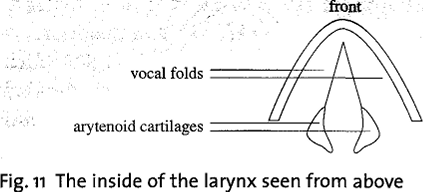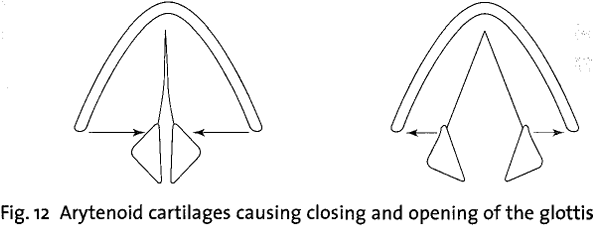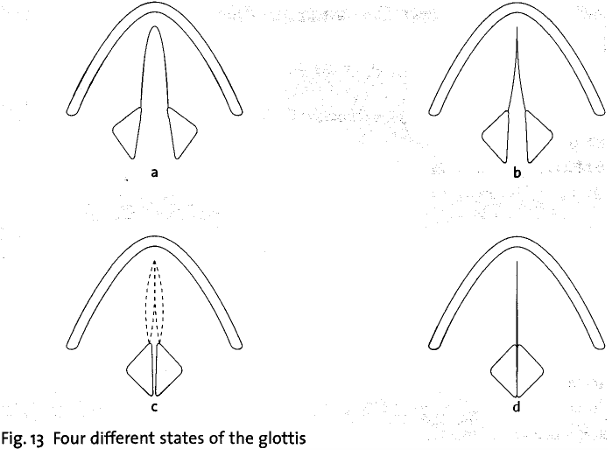
Voicing and consonants The larynx
 المؤلف:
Peter Roach
المؤلف:
Peter Roach
 المصدر:
English Phonetics and Phonology A practical course
المصدر:
English Phonetics and Phonology A practical course
 الجزء والصفحة:
33-4
الجزء والصفحة:
33-4
 2024-10-12
2024-10-12
 1250
1250
Voicing and consonants
The larynx
We begin by studying the larynx. The larynx has several very important functions in speech, but before we can look at these functions we must examine its anatomy and physiology - that is, how it is constructed and how it works.
The larynx is in the neck; it has several parts, shown in Fig. 10. Its main structure is made of cartilage, a material that is similar to bone but less hard. If you press down on your nose, the hard part that you can feel is cartilage. The larynx's structure is made of two large cartilages. These are hollow and are attached to the top of the trachea; when we breathe, the air passes through the trachea and the larynx. The front of the larynx comes to a point and you can feel this point at the front of your neck - particularly if you are a man and/or slim. This point is commonly called the Adam's Apple.
Inside the "box" made by these two cartilages are the vocal folds, which are two thick flaps of muscle rather like a pair of lips; an older name for these is vocal cords. Looking down the throat is difficult to do, and requires special optical equipment, but Fig. 99 shows in diagram form the most important parts. At the front the vocal folds are joined together and fixed to the inside of the thyroid cartilage. At the back they are attached to a pair of small cartilages called the arytenoid cartilages so that if the arytenoid cartilages move, the vocal folds move too.


The arytenoid cartilages are attached to the top of the cricoid cartilage, but they can move so as to move the vocal folds apart or together (Fig. 97). We use the word glottis to refer to the opening between the vocal folds. If the vocal folds are apart we say that the glottis is open; if they are pressed together we say that the glottis is closed. This seems quite simple, but in fact we can produce a very complex range of changes in the vocal folds and their positions.
These changes are often important in speech. Let us first look at four easily recognizable states of the vocal folds; it would be useful to practice moving your vocal folds into these different positions.
• Wide apart: The vocal folds are wide apart for normal breathing and usually during voiceless consonants like p, f, s (Fig. 13a). Your vocal folds are probably apart now.
• Narrow glottis: If air is passed through the glottis when it is narrowed as in Fig. 13b, the result is a fricative sound for which the symbol is h. The sound is not very different from a whispered vowel. It is called a voiceless glottal fricative. Practice saying hahahaha - alternating between this state of the vocal folds and that described in (iii) below.
• Position for vocal fold vibration: When the edges of the vocal folds are touching each other, or nearly touching, air passing through the glottis will usually cause vibration (Fig. 13c). Air is pressed up from the lungs and this air pushes the vocal folds apart so that a little air escapes. As the air flows quickly past the edges of the vocal folds, the folds are brought together again.


This opening and closing happens very rapidly and is repeated regularly, roughly between two and three hundred times per second in a woman's voice and about half that rate in an adult man's voice.
iv) Vocal folds tightly closed: The vocal folds can be firmly pressed together so that air cannot pass between them (Fig. 13d). When this happens in speech we call it a glottal stop or glottal plosive, for which we use the symbol?. You can practice this by coughing gently; then practice the sequence a?a?a?a?a?a.
 الاكثر قراءة في Phonetics and Phonology
الاكثر قراءة في Phonetics and Phonology
 اخر الاخبار
اخر الاخبار
اخبار العتبة العباسية المقدسة


